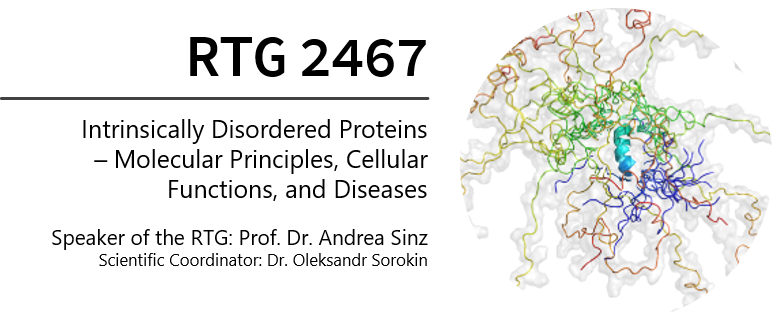
studied Molecular Genetics for a diploma at the University of Vienna, Austria, from 1990 to 1995 and continued to obtain a PhD in Genetics in 1998. His research work as a postdoc (1999-2002) and research associate (2002-2003) was conducted at the Howard Hughes Medical Institute, University of Wisconsin-Madison, WI, USA. In 2004, he moved to the Max Planck Institute for Cell Biology and Genetics in Dresden, Germany, were he worked as an independent junior group leader (2004-2010) and as a senior group leader (2010-2014). In 2015, he became a Heisenberg Fellow and research group leader at the Institute of Biology at the MLU and since 2016 he holds a Heisenberg Professorship of Developmental Genetics at the MLU. His current research interests are to understand how IDRs of the RNA helicase LAF1 contribute to RNA granule integrity and control post-transcriptional mRNA regulation.
Project within the RTG
IDR-dependent cellular functionalization of LAF-1, an essential DDX3 RNA helicase in C. elegans
DEAD-box (DDX) helicases represent the largest subfamily of RNA helicases, guiding essentially all aspects of RNA biogenesis and function (Linder & Jankowsky, 2011). Although all DDX helicases share as RNA-induced ATPases a core helicase region, composed of two RecA-like domains, each enzyme is utilized in different aspects of RNA biology and fulfills diverse biological roles, raising the question of specificity. While sequence variations in their enzymatic core are eminent, additional regions of potential functionality are likely and include IDRs. In this context, DDX3 helicases have recently received increased attention due to their attractive domain architecture: The central helicase core is flanked by two IDRs, each of more than 100 amino acids in length (Elbaum-Garfinkle et al., 2015). Interestingly, the N-terminal IDR rich in arginine-glycine-glycine motifs (RGGs) was found to mediate LLPS in vitro and contributes to cytoplasmic RNA granule biology in different biological systems (Hondele et al., 2019; Valentin-Vega et al., 2016; Elbaum-Garfinkle et al., 2015). Moreover, recent genomic studies identified frequent and recurring missense mutations in human DDX3X as strong oncogenic modulators and the genetic locus of human DDX3X displays haploinsufficiency, underlying intellectual disabilities, or autism-spectrum disorders (Lennox et al., 2020; Elbaum-Garfinkle et al., 2015). While an influence on RNA translation is a likely mechanistic reason for DDX3’s molecular roles in different cellular contexts, i.e., by assisting translational initiation of mRNAs with particularly long/complex 5’UTRs, or by binding directly to the ribosome, other aspects of RNA biology have also been proposed as functional fields of DDX3 helicases. These proposed functional fields include regulating transcription or even DNA integrity via a proposed RNaseH2-like activity (Calviello et al., 2021; Riva et al., 2020; Elbaum-Garfinkle et al., 2015). To date, the functional roles that both IDRs fulfill in any cellular activities of DDX3 helicases as RNP chaperones in a developmental context are still yet to emerge.
Literature references
Website: https://www.biologie.uni-halle.de/institutsbereich_genetik/heisenberg- fellow/2954640_3004625/
